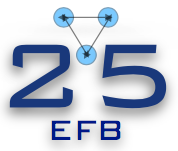Speaker
Description
In the last decade, advances in ab-initio atomic structure calculations enabled the determination of the nuclear charge radius purely from laser spectroscopy measurements and related QED calculations. Especially laser spectroscopy of muonic systems achieved remarkable results in μH [1], μD [2] and μHe [3] which led to the famous proton radius puzzle and questioned the lepton universality proposed by the Standard Model of fundamental interactions. Although convincing evidence for a smaller proton radius was observed in muonic hydrogen [4 – 6], also measurements that support the larger proton radius are reported [7, 8] from atomic spectroscopy. Furthermore, only the nuclear charge radius of H was studied so far with muonic and atomic spectroscopy. Therefore, an extended comparison between muonic and electronic systems is demanded.
In order to expand the all-optical approach towards heavier atomic systems than hydrogen, precise atomic structure calculations for two-electron systems are needed since no laser addressable transitions exist in H-like systems beyond hydrogen. Related non-relativistic QED (NR-QED) calculations [9] made significant progress recently and surpassed the available experimental precision in many elements. In order to test these calculations beyond Li, high-precision collinear laser spectroscopy has been performed from the metastable $1s2s\,^3$S$_1$ state with a lifetime of $21\,$ms to the $1s2p\,^3$P$_J$ states in C$^{4+}$ at the Collinear Apparatus for Laser Spectroscopy and Applied Science (COALA), situated at the Institute for Nuclear Physics at the TU Darmstadt.
This contribution will present the first high-precision laser spectroscopy in the isotopic chain of carbon and the first all-optical nuclear charge radius of $^{12}$C. This project is supported by the German Research Foundation (Project-ID 279384907 – SFB1245).
[1] R. Pohl et al., Nature 466, 213 (2010)
[2] R. Pohl et al., Science 353, 669 (2016)
[3] J. J. Krauth et al., Nature 589, 527 (2021)
[4] A. Beyer et al., Science 358, 79 (2017)
[5] N. Bezginov et al., Science 365, 1007 (2019)
[6] W. Xiong et al., Nature 575, 147 (2019)
[7] H. Fleurbaey et al., Phys. Rev. Lett. 120, 183001 (2018)
[8] A. D. Brandt et al., Phys. Rev. Lett. 128, 023001 (2022
[9] V.A. Yerokhin et al., Phys. Rev. A 106, 022815 (2022)

